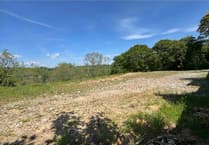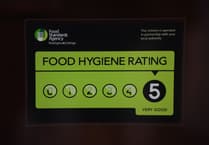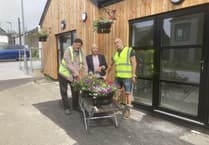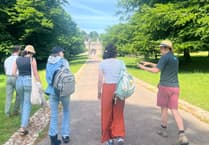MANY people see Hessenford only as a flash of houses, glimpsed briefly as they plough through on the A387 holiday route to Looe.
This village's name signifies 'witches ford', prompting thoughts of intriguing events deep in its history. Today's Hessenford is indeed a magical place and anyone who gives more than a passing glance will want to stop to uncover what secrets it now holds....
There has long been a settlement here at the foot of this wooded valley bridging the Seaton river; writing in 1868, historian J Polsue tells of an 'ancient chapel situated in a wood at Hessenford, dedicated to St Anne, some remains of which are yet to be seen.' A new, small chapel of ease was built in 1863, and in 1871, permission was given to rebuild the church as it now appears, in early-English style with a barrel-vaulted roof.
One of the earliest records is of a mill, in 1286. Today the job of restoring Hessenford's two mills with their waterwheels is almost complete - the culmination of a year's very hard work by the current owners, the Deacon family.
The older and larger mill was first used by local farmers who bought their corn - later it was purchased by seed merchants Bibbys, who used it as a grain store.
Unique
For some years now the millhouse has been private accommodation and holiday flats. Andrew Deacon showed us into his lounge which has a startling and unique feature - the wooden workings of the wheel are on full display behind a glass partition. As he said, certainly a talking point! The mechanism is in perfect condition, and the Deacons intend to use it for demonstrations.
A second, smaller mill in the same location was used to make joinery for local buildings up until fairly recently - its last job being to make new windows and doors for the church, St Annes, in the 1940s. Fearing that it would be demolished, the Deacons bought this mill too in May, and set about putting their vision into reality - to restore both waterwheels to working order. The wheels, one overshot and one undershot, are powered by water from two separate leats.
Electricity
As Andrew showed us to the smaller wheel, he explained: 'The leats hadn't been in use since the 1940s, and I think had certainly been dry for about 30 years. The overshot leat goes back about one and a half miles before it links up with the river - a lot of work had to go in to restoring the bridges and the sluice gates.'
Andrew now hopes that the smaller wheel can be used to generate electricity for the main house - using the same simple mechanism that provided power for the Copley Arms in the 1940s and 50s, and is still going strong today. The Deacons intend to turn the building that houses the generator into a workshop and museum for guests or anyone in the village who wants to look around.
Spirit
As if all this work wasn't enough, the family have also converted part of the back of the millhouse into a flat - this section of the building used to be the site of the village post office.
Hessenford no longer has its post office and its shop closed five or six years ago - but since then the garage has partly taken on the role, selling 'odds and ends' like milk and the daily papers. Cheerful owner Brian Northcott, not from the village himself, told how 'it's changed like all rural villages - communities have lost some of their village feel and spirit.'
Mary Bosworth has certainly witnessed many of the changes - born in a cottage in the village, she grew up and made her home in Hessenford and has been here all her life. Today Mary runs a bed and breakfast from her home on the winding road out of Hessenford to Seaton.
She said there was still plenty going on in the village to keep people together: 'There's still a sense of community here - we had a church fete the other week and collected over £1000.'
'The pub is another meeting place for people, we had a smashing time for the millennium.'
Mary and all her siblings went to Hessenford school - on the site of what is now the church hall, the school closed in the 1960s, and village children started attending school in Downderry.
A photograph taken in 1940 at the school shows Mary with her twin brother Peter, their older twin brothers Nigel and David and sister Pat - the family must have made up around a third of the school register!
Bobby
Mary described a childhood of 'going to Seaton swimming, school, and sometimes the pictures in Plymouth.'
'We used to have a lovely time,' she recalled, 'going up into the woods and playing what we called 'granny houses.' These were dens the children made using sacks for roofs and bits and bobs from home.
As well as a youth club attended by about 40 children in Mary's time, there was also Sunday school. This was held in the Wesleyan chapel, whose services ceased around seven years ago, and is now a private home.
The village also had its own bobby, who lived at what is now called Peel Cottage - which even had its own lockup in the back for miscreants! When Mary was a girl Hessenford's policeman was a Mr Balford, and she remembers playing cards in the kitchen with her mother and Mrs Balford.
Mary was married to Terry in 1956 in the village church - and as was tradition, a volley of shots were fired for the couple. The original church building had no bell and so shotgun weddings became the practice for local girls.
Three generations of Mary's family still live in Hessenford - her daughter Amanda Goodaire works at the Copley Arms and lives just opposite her Mum with husband Alan and their son Edward. Amanda highlighted the problem of finding affordable accommodation in the village she grew up in; at present she lives in a mobile home, but this is a small price to pay for staying in the place she loves.
'I've worked at the pub for 16 years,' Amanda explained, 'and it's a really nice village. Its nice for Edward to grow up in the same village as I did.'
She didn't think things had changed much since she grew up herself in Hessenford: 'You've still got to go everywhere else for everything else,' she laughed, 'I'm doing the same taxiing around that my parents did!'
As bar manageress, Amanda is the linchpin of a large staff at the busy Copley Arms. Things were even more hectic than normal when we arrived, as dredging was going on in part of the river that runs through the pub grounds. Landlord Geoff Rodgers explained how once there were two public houses: 'There used to be another pub called the Cornish Arms over the road, in the house next to the old school house - we think it was the oldest building in the village.'
Floods
Floods can be a problem for the pub and for the row of houses opposite, and the dredging work currently being carried out aims to prevent high waters wreaking havoc in the future.
'The River Seaton floods yearly,' said Gary Watkins of Caradon Council, who are responsible for the bridge and the section of river that flows beneath. 'All the tributaries come in at Hessenford, and when the river is at full bore, the village suffers.'
Mr Watkins explained that 50 years ago, it was possible to walk under the arches of the bridge. Now there is only 35 centimetres clearance, so the river is being dredged to allow the maximum water flow possible down to the river mouth at Seaton.
Silt and stones taken from the river will be used to lay new footways in the nearby Seaton nature park.
The river marks the boundary between two halves of Hessenford - on the west, land was part of the Duchy of Cornwall, and to the east, part of the Bake estate, which owned many of the farms in the area. Now nearly all of the estate's properties have been sold, but the name at least lives on; leaving the village over the brow of a steep hill towards Trerulefoot, Bake manor appears and then Bake fishing lakes, owned by the Listers.
The lakes are open to all for both coarse and fly fishing and occupy an area populated with abundant wildlife - popular with twitchers as well as those hoping to hook carp, roach or bream.
Snooker
Back down in Hessenford itself, the working men's club with its distinctive clock is still being used by villagers. The institute, already in use as a meeting place for agricultural workers, was given to the village by Captain Summers Cocks of the Bake estate in 1955.
Today it is mainly used as a snooker and billiards hall, but is available to villagers for any purpose. Outside a celtic cross stands 'in grateful remembrance to those who laid down their lives 1914-1918.'
Next door in fuchsia cottage lives Mrs Jean Retallick, whose late husband was a gardener on the estate. She has been in the village for 38 years, and remembers how the mill was still in use when she first arrived.
Jean is a member of the popular mixed skittles team, as she explained: 'There are a group of about 20 or 30 who have been together for eight or nine years. We meet every other week all year round - and we've just been promoted from Division three to Division two.'
Another important activity is the WI; about 30 strong, they are a very active group and will soon mark their 75th anniversary. They meet in the church room, also the venue for the skittles, whist drives and a craft group.
Hessenford has strong twinning links; as part of the parish of St Germans, the village was twinned with Plougarneau in Brittany.
When the parish of St Germans was split in two, Hessenford became part of the new Deviock parish, but retained its link with the Breton village.
There will soon be a further French connection; after 14 years as parish vicar, Rev Stephen Coffin is to take up a post in the city of Grenoble, in October.



